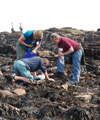October
Capturing our coast

Newcastle University has received initial support from the Heritage Lottery Fund for a £1.7m project to help protect our coastline for future generations.
Designed to further our understanding of the abundance and distribution of marine life around the entire UK coastline, the project will train over 3,000 volunteers – making it the largest marine citizen science project ever undertaken in the UK.
Collecting data around key indicator species, the research will help us to understand how the marine environment is responding to global climate change and inform future policy and conservation strategies.
Marine Life
Led by Newcastle University’s Dove Marine Laboratory, the “Capturing our Coast” project also involves the universities of Hull, Portsmouth, Bangor and the Scottish Association for Marine Science, and a number of key organisations including the Marine Biological Association in Plymouth, the Natural History Museum and the Coastal Partnerships Network.
“Collecting this information about our coastlines is vital if we are to protect them for the future but we can’t do it without the help of the public,” explains project lead Dr Jane Delany, a senior lecturer in the School of Marine Science and Technology at Newcastle University.
“What this project aims to do is develop a network of citizen scientists who can help us build an accurate picture of marine life all around the UK - a baseline against which we can better understand the impact of climate change and other environmental and human factors.
“It gives us the opportunity to carry out the same experiment at the same time to gain an accurate picture of the ecological processes in the marine environment across different latitudes and environmental conditions. This data will then feed into a national database and inform future policy, conservation and science.”
Coastline
The project builds on previous work led by Newcastle University through the Big Sea Survey. Launched in 2010, the team recruited 357 citizen scientists to log flora and fauna along a 150 mile stretch of coastline from St Abbs to Saltburn.
Collecting 350,000 separate records over three years, the team identified a number of organisms which had previously not been seen so far north such as the rare stalked jellyfish and an invasive species of sea squirt known as Corella eumyota.
“One of the criticisms of citizen science is the accuracy of the data collected,” explains Dr Delany.
“What is unique about the Newcastle projects is that we have turned all our volunteers into ‘specialists’. Instead of asking them to record everything they see, each volunteer is trained as an expert in just five species and this has been hugely successful.”
Through the “Capturing our Coast” project there will also be the opportunity for wider engagement with communities across the UK through workshops, social media and other events.
HLF also today announced a £1.3million grant to the Freshwater Habitats Trust for a nationwide mass-participation project that seeks to gather valuable information about pond habitats.
Commenting on both awards HLF Trustee and former Chief Scientist at Natural England Dr Tom Tew said: “Many people’s earliest and fondest memories are of peering at a crab in a rock pool on the beach or fishing for tadpoles in a murky pond. Countless species rely on these valuable habitats yet we lack critical information about how abundant and valuable they are and, in many cases, why they are at risk.
“It’s easy to feel a bit helpless when we hear how nature is declining so we loved the way these projects will harness people’s desire to help. Helping people across the country to reconnect with nature - through recording the wildlife associated with our coasts and ponds - will make a really positive long-term difference both to people's enjoyment of the countryside and to the state of nature.”
published on: 30 October 2014
